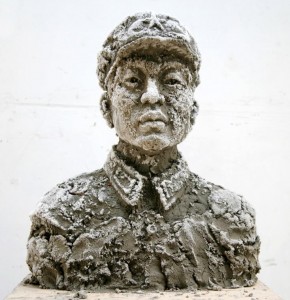by Durriya Dohadwala –
The third edition of the Collector’s Show is now on at the Singapore Art Museum. The exhibition, which is usually timed to open with and complement Art Stage Singapore, showcases 23 works from private collections around the world. Held together with the theme “Weight of History”, the works are an exploration on how the past has shaped the present; via memories, traditions, culture and values. Also under investigation is art history and its continuing influence on the art of today.
A theme that seems to be a favourite amongst many of the regions contemporary artists is that of reconstruction, using discarded or waste materials to explore notions of beauty and permanence, and the effect of modern technologies and culture on our lives.
One of the highlights of the show is the work of Korean artist Yee Sookyung’s Translated Vase. This is a lyrical piece which is constructed by meticulously piecing together shards of ceramic waste. Each fragment maintains its original curved shape, yet comes together to form a new visually appealing structure; a comment on the possibility of building the present without forgoing the values and traditions of the past. The work is also a linguistic play on how perception is shaped. She observes, “I wanted to add a sense of humour to my work by filling geums (cracks), which are considered as defects, with a valuable material, such as real geum (gold).”
Zhang Huan’s Ash Army No 2 is a military figure sculpted from discarded incense ash. Using a material that is the remnant of a devotional act, the artist explores the notion of memories and their fragility in man’s imagination. Huan, a well-known contemporary artist from China, also has his monumental work, The Berlin Buddha on show at this week’s Art Stage Singapore.
This edition of the collector’s show includes for the first time works of Australian and Tibetan artists. Tony Albert’s A Collected History is a collage of aboriginal memorabilia that he has collected over many years. Made up of souvenir items, paintings and sculptures, each piece represents how Aborigines, their culture and traditions, and their place in society have been stereo typed and redefined in Australian history. UFOs painted onto several pieces in the work serve as an icon of the alienation of the Aborigines and how the indigenous people have become foreign in their own homeland.
Tibetan artist, Gonkar Gyatso has two works in the exhibition both blending the classical religious with modern-day pop iconography. The work Excuse Me while I Kiss the Sky takes its title from the Jimi Hendrix’s song Purple Haze and is a sculpture of a seated Buddha covered in layers of colourful stickers that are popular with children today. Starting with a sacred and historical icon, Gyatso reinvents it with modern media that represents the consumerism and global homogenization of today, to keep it relevant and current. The second work, 108 Burning Questions consists of a series of 108 frames which line the walls of the exhibit. Each frame is a collage of stickers and images from magazines, newspapers and other popular media positioned around the centrally placed Tibetan Buddhist protective rings of fire. A burning question on today’s social, political and environmental issues runs around the inner frame. The number 108 is significant as it has religious significance in Buddhism and Hinduism.
Simultaneously exploring the weight of history on art and society is Shazia Sikander’s Explosion of the Company Man. The work references two historical art traditions of the Indian subcontinent; Miniature painting and the Company Style are reinvented to comment on how the legacy of the colonial past impacts the present. Evolved from the traditional miniature painting technique, contemporary miniature is a new art form that incorporates elements of the historical tradition with the contemporary. The intricate detailing and arabesque motifs in the work come from the traditional technique, but the scale (203x20x173 cm) and subject matter are a contradiction to the miniature style. The open folio also references the Company Style of painting that was favoured by the colonial elite in India during the 19th century to depict local images that catered to European tastes. The left hand side of the work contains floating pieces that seem to be an exploded version of the company man depicted on the right hand side, a metaphor perhaps for the effects of colonialism and the legacy that the past has left behind.
History is shaped by our memory. What is forgotten and what is remembered both play an important part in creating individual and group identities. While overindulgence in either can distort reality and be harmful to people and societies, remembering to draw on history and learn from its experiences can help shape a better future.
This article first appeared on www.aisanarthappenings.com February 2013.
Durriya Dohadwala is currently a student of the MA Asian Art Histories Programme
The Collectors Show: Weight of History runs at Singapore Art Museum until May 5 2013


